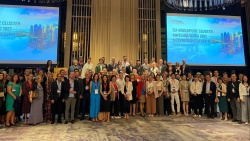This is the BILASURF project, in which secpho participates together with its partners CEIT and AIMEN and a European consortium with entities from Germany, France, Lithuania and Austria to develop and integrate a more efficient and sustainable laser functionalisation process for complex 3D surfaces.

Surface functionalisation is present in a wide range of sectors, improving the performance of multiple components and systems. However, its application in complex industrial parts brings several challenges linked to its production, integration and its impact on the environment. Challenges that Bilasurf and its partners will try to overcome.
Reduction of friction
The objective of this plan is to develop and integrate a process for high-speed laser functionalisation of complex 3D surfaces using custom-designed bio-inspired riblets to reduce friction and improve the environmental footprint of industrial parts, ensuring high performance with the help of online monitoring capabilities. In other words, the aim is to create a process that enables medium to large parts and complex 3D shapes to increase their performance by reducing surface friction.
The demonstrators selected for the initiative are hydroelectric power turbines and industrial fans. Microstructures will be designed based on biological surfaces such as shark skin, which have proven their ability to reduce friction.
The Bilasurf consortium will develop a prototype in the form of an integrated system that will include the laser process, a handling system for the parts to be textured, as well as the new real-time monitoring system.
Demonstrators
From this prototype, two final demonstrators will be built. On the one hand, a scaled-up hydro-generation turbine will be textured and its performance will be tested according to international standards. On the other hand, a mould used to manufacture industrial fans will also be textured. These will be tested to measure their energy consumption and the noise they emit into the environment.
Once the project is completed in 2025, and if it is extended to the different industrial sectors, the initiative is expected to have a great impact thanks to its capacity to reduce energy consumption, increase generation performance – in the case of turbines and similar elements – and reduce waste, as it is a clean manufacturing process.



